Question
Table below shows the historical returns for Companies A, B and C Year Company A Company B Company C 1 30% 26% 47% 2 7%
Table below shows the historical returns for Companies A, B and C
| Year | Company A | Company B | Company C |
| 1 | 30% | 26% | 47% |
| 2 | 7% | 15% | -54% |
| 3 | 18% | -14% | 15% |
| 4 | -22% | -15% | 7% |
| 5 | -14% | 2% | -28% |
| 6 | 10% | -18% | 40% |
| 7 | 26% | 42% | 17% |
| 8 | -10% | 30% | -23% |
| 9 | -3% | -32% | -4% |
| 10 | 38% | 28% | 75% |
| 11 | 27.0% | 23.4% | 42.3% |
| 12 | 6.3% | 13.5% | -48.6% |
| 13 | 16.2% | -12.6% | 13.5% |
| 14 | -19.8% | -13.5% | 6.3% |
| 15 | -12.6% | 1.8% | -25.2% |
| 16 | 9.0% | -16.2% | 36.0% |
| 17 | 23.4% | 37.8% | 15.3% |
| 18 | -9.0% | 27.0% | -20.7% |
| 19 | -2.7% | -28.8% | -3.6% |
| 20 | 34.2% | 25.2% | 67.5% |
1. If one investor has a portfolio consisting of 70% Company A and 30% Company B, what are the average portfolio return and standard deviation? What is Sharpe ratio if the risk- free rate is 3.5%?
2.If another investor has a portfolio consisting of 1/3 Company A, 1/3 Company B and 1/3 Company C, what are the average portfolio return and standard deviation? What is Sharpe ratio if the risk-free rate is 3.5%?
Step by Step Solution
There are 3 Steps involved in it
Step: 1

Get Instant Access to Expert-Tailored Solutions
See step-by-step solutions with expert insights and AI powered tools for academic success
Step: 2

Step: 3

Ace Your Homework with AI
Get the answers you need in no time with our AI-driven, step-by-step assistance
Get Started


